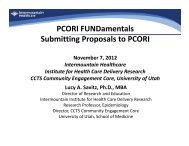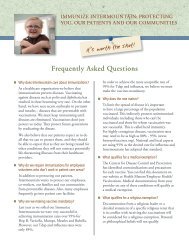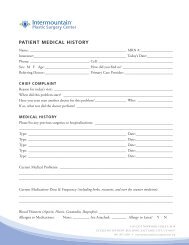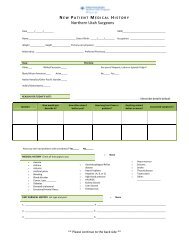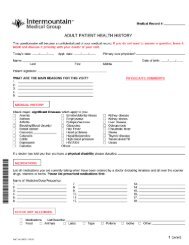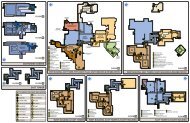Utah Valley Regional Medical Center CHNA - Intermountain ...
Utah Valley Regional Medical Center CHNA - Intermountain ...
Utah Valley Regional Medical Center CHNA - Intermountain ...
You also want an ePaper? Increase the reach of your titles
YUMPU automatically turns print PDFs into web optimized ePapers that Google loves.
Community Health Needs Assessment Background<strong>Utah</strong> <strong>Valley</strong> <strong>Regional</strong> <strong>Medical</strong> <strong>Center</strong> was part of <strong>Intermountain</strong>’s 2009 health status study(conducted prior to the ACA-required <strong>CHNA</strong>) to identify significant community health needs,especially for low-income residents in <strong>Utah</strong> and southern Idaho communities. From data gatheredand in consultation with nonprofit and government partners, <strong>Intermountain</strong>’s Community BenefitDepartment established health priorities dealing with these main issues:1. Chronic disease associated with weight and unhealthy behaviors;2. Access to healthcare for low income populations; and3. Access to behavioral health services for low income populations.These priorities met <strong>Intermountain</strong> objectives to improve healthcare for low-income populations,reduce the cost of healthcare for <strong>Intermountain</strong> and the community, and assure <strong>Intermountain</strong>meets the hospital healthcare needs of each community where its hospitals are located. The healthpriorities aligned with Healthy People 2010 5 goals and <strong>Intermountain</strong> clinical goals. <strong>Intermountain</strong>hospital leaders used the health priorities to identify health improvement strategies and developCommunity Benefit programs and the community health goals of its individual hospitals, clinics, andother initiatives.The Patient Protection and Affordable Care Act (ACA) signed into law in March 2010 requires eachnonprofit hospital to perform a <strong>CHNA</strong> every three years and use the findings to develop three-yearimplementation strategies to address identified community needs. The ACA requires that eachnonprofit hospital solicit input from individuals representing broad interests of the community todiscuss health needs within the community, gather quantitative data on significant health needs,make the <strong>CHNA</strong> results public, and report how it conducted the <strong>CHNA</strong> and developed a three-yearimplementation strategy on the IRS Form 990 Schedule H Section V.<strong>Intermountain</strong>'s Community Benefit Department created a system-wide process to be used by eachof its 21 hospitals in conducting components of the <strong>CHNA</strong>: 1) asking for community inputregarding local healthcare needs; 2) quantitative data collection; 3) developing an implementationstrategy; and 4) making the <strong>CHNA</strong> results publicly available.<strong>Intermountain</strong> clinical staff determined to use the health priorities identified in the previous healthstatus report for the 2013 quantitative data collection and in order to identify any changes in thehealth indicators over the past few years; 37 health indicators were selected for the health prioritycategories. These priorities were also used to elicit perceptions of invited participants in thehospital’s community input meeting. The broad categories identified in 2009 remain significanthealth issues for communities served by <strong>Intermountain</strong> hospitals. Following is additionalinformation to illustrate how each priority remains an area of focus:5 www.healthypeople.gov/2010/6




